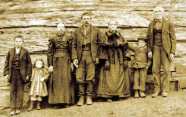| Notes |
- The following is an excerpt from northwestern North Carolina historian Michael Hardy:
About the same time that Samuel Bright was settling down near the present-day site of the Avery County Airport, near Ingalls, David Hix was settling in the Valle Crucis area of Watauga County. His home was surrounded by a palisade wall and was generally known as Hix's Fort. He was living there with his family, including his two sons, Samuel and David; his two sons-in-law, Thomas and Mikel Asher; two other men named Lucus and Asher, and a hired woman named Ireland, along with her daughter, Jenny.
Born in Goochland County, Va., about 1719, Hix lived in Surry County, along Peters Creek for eight or 10 years prior to coming to Valle Crucis. A writer in 1885 described Hix as a "man of great strength and power of endurance, a skillful hunter and woodsman, simple in his habits, of a kind and accommodating disposition and possessed of many good traits."
For a brief amount of time, the group moved further down the Watauga River, living near Dugger's Iron Works in what is present-day Carter County. It was here that Jenny was abducted, probably by the Shawnee; she lived for seven years near the Ohio River and married one of their warriors. She was later purchased by some "Indian traders" and was eventually able to return to her mother.
Hix lived at Dugger's Iron Works for maybe a year before returning to Valle Crucis. One source puts him back on the upper section of the Watauga River about 1776 or 1777. As the American Revolution broke out on the frontier as well as in the more populated sections of the Colonies, Hix's position became more complicated and difficult. In fact, it is not even very clear where his loyalties actually were. One source considered Hix a Tory, while another considered him to be of a more neutral position. Clearly, Col. Benjamin Cleveland, Patriot leader and legendary foe of Tories in the backcountry, believed Hix was an enemy to the Patriot cause. At one point, Cleveland traveled from Wilkesboro and laid siege to Hix's Fort. After a few days, Hix believed that Cleveland had retreated, and when the settlers ventured forth, Cleveland ambushed them, killing Hix's son-in-law Mikel Asher and wounding David Hix. Cleveland's men then plundered Hix's Fort.
Hix had additional problems not connected to the Revolution. In another instance, Hix allowed some cattle drovers to stay at his fort. Moving livestock through the backcountry to reach a market could be an arduous process. However, after the presumed drovers had left the fort, a group came from Wilkes County looking for them. It seems the cattle were actually stolen. The posse caught up with them and killed the cattle rustler, a man named Grimes.
At some point, it appears that the Hix family fled their fort in Valle Crucis. The family came to the area near present-day Banner Elk, presumably at some point during the American Revolution. John Preston Arthur, in his history of Watauga County, tells us that Hix eventually "became uneasy and retired to the wilderness near what is now Banner Elk, where he made camp and supported himself by hunting and making maple syrup and sugar, thus avoiding service as an American or a Tory." Hix did manage to avoid swearing allegiance to either side during the war. Arthur goes on to tell us that people 100 years ago still plowed up coal "near the Lybrook farm, near the Grandfather Orphanage" and that local people knew the area as the Hix Improvement, "that being the place here Samuel Hix 'laid out during the Revolutionary War.'"
It is possible that David Hix died in the Banner Elk area in 1792 or 1793. His will, drawn up by a resident from Washington County (now Tennessee), was probated in Wilkes County.
John Preston Arthur tells us that there "were no clearings of any extent at Banner Elk, except those at the Hix Improvement, which was very small, and at Big Bottoms but there were two 'deadenings,' one called the Moses Deadening and the other the Lark Chopping." These last two were probably locations where trees had been cut in such a way where their death was certain, thus opening up new ground for cultivation.
Arthur also tells us that David Hix soon had neighbors: Baker King and Ben Dugger. There are plenty of Duggers still in the area. Members of the Hix family are also still here in Avery County, but, over time, the name has morphed into the more familiar Hicks. Though there were others seeking to settle in the region well before the 1840s, it would be the Banner family whose name would stick to the community.
|






 d. Aft 1764, Granville County, , , North Carolina
d. Aft 1764, Granville County, , , North Carolina  (Age ~ 85 years)
(Age ~ 85 years) 